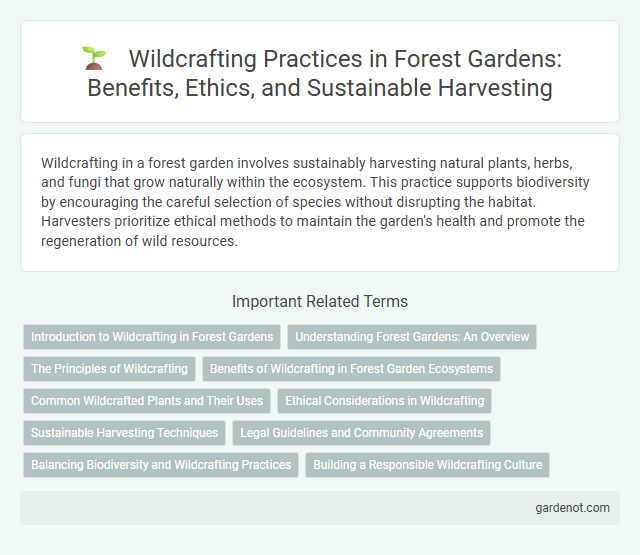Wildcrafting in a forest garden involves sustainably harvesting natural plants, herbs, and fungi that grow naturally within the ecosystem. This practice supports biodiversity by encouraging the careful selection of species without disrupting the habitat. Harvesters prioritize ethical methods to maintain the garden's health and promote the regeneration of wild resources.
Introduction to Wildcrafting in Forest Gardens
Wildcrafting in forest gardens involves sustainably harvesting plants and herbs directly from their natural habitats within the garden ecosystem. This practice emphasizes respecting plant populations and ecosystems to ensure long-term health and biodiversity. Wildcrafting supports the integration of foraged food, medicine, and materials into permaculture designs, enhancing resilience and self-sufficiency.
Understanding Forest Gardens: An Overview
Wildcrafting in forest gardens emphasizes sustainable harvesting of native plants, promoting biodiversity and ecosystem health. This practice relies on understanding species' growth cycles, habitats, and regenerative capacities to maintain balance within the garden's layered structure. Integrating wildcrafting supports nutrient-rich yields while preserving the forest garden's long-term resilience.
The Principles of Wildcrafting
Wildcrafting revolves around harvesting plants and herbs from their natural habitats with respect for ecological balance and sustainability. Key principles include harvesting only what is abundant, avoiding damage to the plant population, and ensuring that the environment remains healthy for future growth. Ethical wildcrafting supports biodiversity, promotes natural regeneration, and fosters a deep connection between humans and the forest garden ecosystem.
Benefits of Wildcrafting in Forest Garden Ecosystems
Wildcrafting in forest garden ecosystems promotes biodiversity by sustainably harvesting native plants, which supports pollinators and wildlife habitats. This practice enhances soil health through minimal disturbance and encourages natural regeneration of flora. Incorporating wildcrafted species increases ecosystem resilience and provides diverse, nutrient-rich food and medicinal resources for human use.
Common Wildcrafted Plants and Their Uses
Common wildcrafted plants in forest gardens include dandelion, yarrow, and nettle, valued for their medicinal and nutritional properties. Dandelion leaves provide vitamins A and C, while yarrow is known for its anti-inflammatory and wound-healing effects. Nettle offers a rich source of iron and can be used to make nutritious teas and soups, supporting both health and sustainability in forest garden ecosystems.
Ethical Considerations in Wildcrafting
Wildcrafting in a forest garden requires strict adherence to ethical considerations to preserve biodiversity and ecosystem health. Harvesters should only collect plants from abundant populations, avoid damaging root systems, and leave enough material to ensure natural regeneration. Respecting local regulations and indigenous knowledge is essential to maintain sustainability and prevent overharvesting.
Sustainable Harvesting Techniques
Wildcrafting in forest gardens emphasizes sustainable harvesting techniques that protect plant populations and ecosystem health. Selective picking, seasonal awareness, and minimal disturbance ensure long-term resource availability while maintaining biodiversity. Implementing rotational harvesting cycles and respecting natural regeneration rates supports a resilient and productive forest garden environment.
Legal Guidelines and Community Agreements
Wildcrafting in forest gardens requires adherence to local legal guidelines that regulate the harvesting of native plants to protect biodiversity and prevent overharvesting. Community agreements often establish sustainable practices and seasonal restrictions, ensuring the regeneration of wild resources and respecting indigenous rights. Respect for legal and communal frameworks promotes ecological balance and fosters cooperative stewardship within forest garden ecosystems.
Balancing Biodiversity and Wildcrafting Practices
Wildcrafting in forest gardens requires careful management to maintain ecological balance and prevent overharvesting. Promoting diverse plant species supports habitat stability and ensures sustainable resource availability. Integrating ethical harvesting guidelines preserves native flora and enhances long-term biodiversity resilience.
Building a Responsible Wildcrafting Culture
Building a responsible wildcrafting culture in forest gardens promotes sustainable harvesting practices that protect native plant populations and their ecosystems. Emphasizing ethical guidelines, such as harvesting only abundant species and leaving enough plants to regenerate, ensures biodiversity and long-term availability of wild resources. Community education and collaboration foster respect for natural habitats while supporting traditional knowledge and conservation efforts.
Wildcrafting Infographic

 gardenot.com
gardenot.com